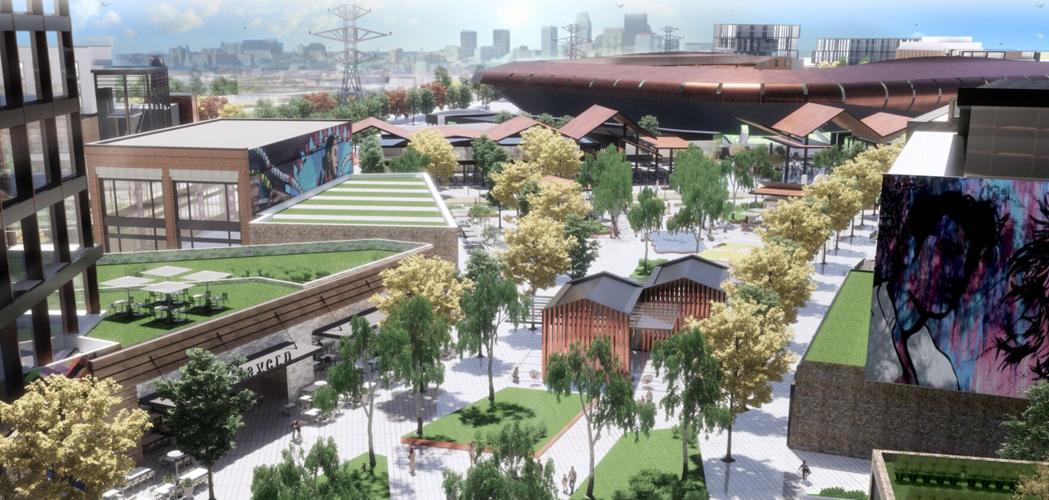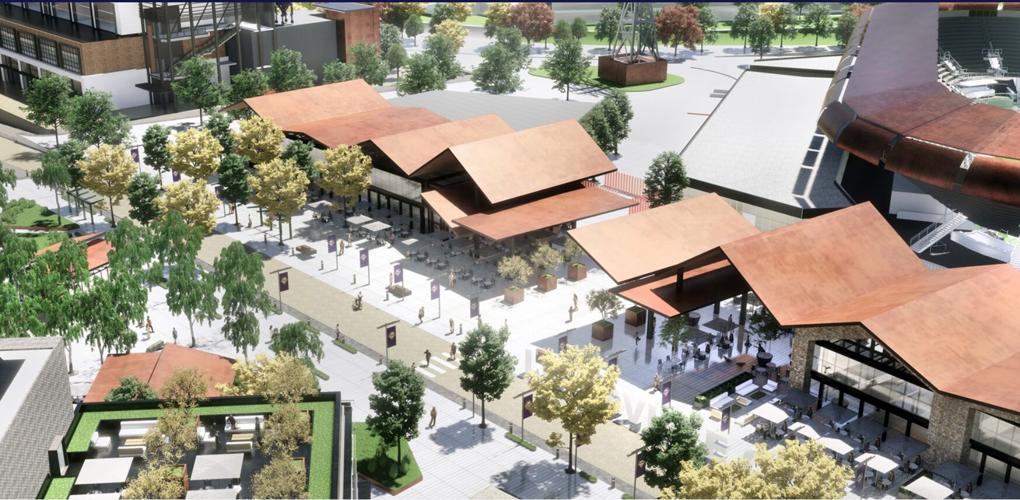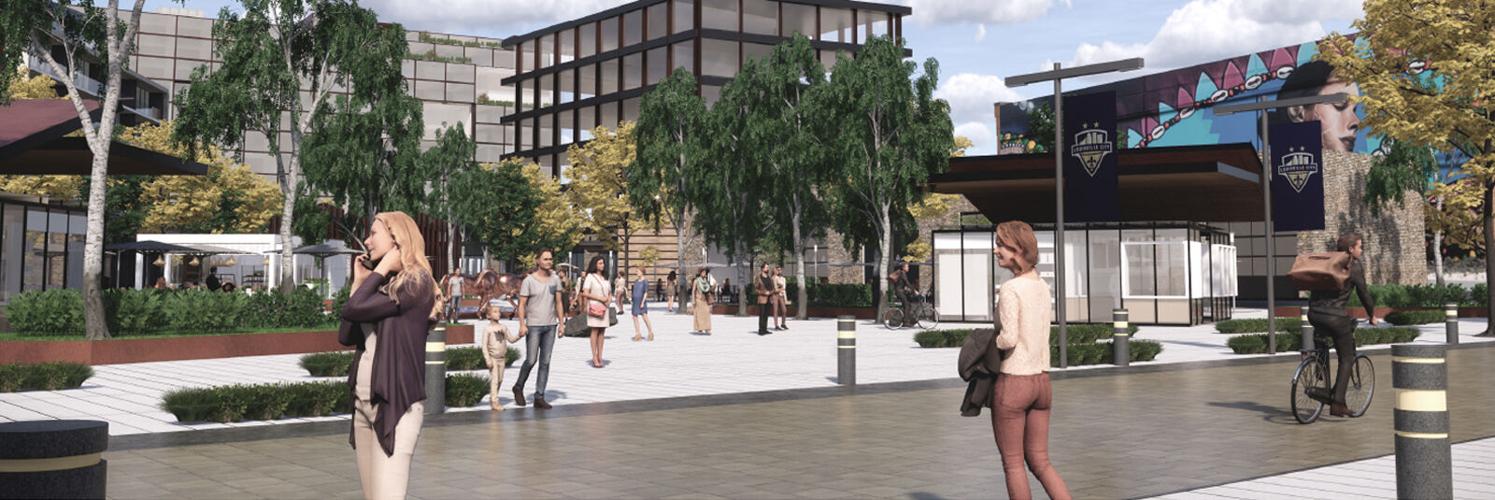[ad_1]
LOUISVILLE, Ky. (WDRB) — The owners of Louisville City FC secured public subsidies in 2018 under a deal that required more than building a new soccer stadium in Butchertown.
In getting approval to use state and local funds to help cover development costs, the stadium’s backers proposed an entirely new district on more than 30 blighted acres near Waterfront Park: two hotels with 308 rooms between them, 340,000 square feet of office space and roughly 70,000 square feet of retail and restaurant space.
Lynn Family Stadium opened as the COVID-19 pandemic began in 2020 and since then has hosted games for the professional Louisville City and Racing Louisville teams and other events. But no other work has occurred nearby.
As a result, the property tax revenues meant to reimburse Louisville Metro government for its upfront investment in the project have lagged well behind expectations. So too have other tax dollars projected to line city and state coffers.

An aerial view of Lynn Family Stadium and the area surrounding it (WDRB photo).
The original plans also have changed. While not part of the earlier mix of uses, apartments are now envisioned on the site, as is a “large family entertainment opportunity.”
Heading into 2023, the area surrounding the stadium was supposed to be built up far more than it is, according to a development schedule included in documents WDRB News obtained under Kentucky’s public records law.
Those projections, part of an analysis commissioned by the Kentucky Cabinet for Economic Development, show office/retail/restaurant buildings producing tax revenue in 2021 and a hotel doing so in 2022. But those aspects of the Butchertown district haven’t happened.
Mike Mountjoy, a member of the stadium ownership group, told WDRB in 2018 that discussions were underway at that time with four or five potential tenants about office space. He also said several restaurants also had expressed interest.
While there still might be “some office” space in the overall project, “that whole product line has changed based on demand right now,” said Tim Mulloy, a board member of Soccer Holdings LLC, the owners of Louisville City and Racing Louisville.
The changes represent the nature of real estate deals, he said.
“Some work and some don’t,” Mulloy said. “So we’re sitting on a couple of opportunities right now that we’re very excited about.”
One involves an interested apartment developer, Mulloy said, and the other “a family entertainment operator who operates a very well-known and very successful large venue who is looking at one of our tracts right now.”

Lynn Family Stadium District Renderings
The stadium’s backers proposed an entirely new district on more than 30 blighted acres near Waterfront Park: two hotels with 308 rooms between them, 340,000 square feet of office space and roughly 70,000 square feet of retail and restaurant space. Photo courtesy of NB Develop/ButchertownLou.com.

Lynn Family Stadium District Renderings
The stadium’s backers proposed an entirely new district on more than 30 blighted acres near Waterfront Park: two hotels with 308 rooms between them, 340,000 square feet of office space and roughly 70,000 square feet of retail and restaurant space. Photo courtesy of NB Develop/ButchertownLou.com.

Lynn Family Stadium District Renderings
The stadium’s backers proposed an entirely new district on more than 30 blighted acres near Waterfront Park: two hotels with 308 rooms between them, 340,000 square feet of office space and roughly 70,000 square feet of retail and restaurant space. Photo courtesy of NB Develop/ButchertownLou.com.

Lynn Family Stadium District Renderings
The stadium’s backers proposed an entirely new district on more than 30 blighted acres near Waterfront Park: two hotels with 308 rooms between them, 340,000 square feet of office space and roughly 70,000 square feet of retail and restaurant space. Photo courtesy of NB Develop/ButchertownLou.com.
Mulloy declined to name the company because of a non-disclosure agreement but said: “You would know who they were.”
Taken together, he estimated that those two developments would take up about 12 acres of the 37-acre property. The stadium parcel is slightly more than 12 acres.
If the apartment project happens, “I believe that will lead to what I think is our third deal: a retail center,” Mulloy said.
Shane Uttich, whose company, NB Develop, is marketing the property, said local, regional and national developers have shown interest in the site since the stadium’s owners created a committee about a year ago to evaluate how to move forward with the land.
And, in some cases, he said, committee members have pushed back when development proposals haven’t fit the goals.
“Ultimately, we want to see the city of Louisville and the fans of both the men’s and women’s side be happy with the outcome,” Uttich said.
‘Speculative investments’
Louisville City owners settled on the Butchertown site in 2017 as the new home for their team, which then was playing at the Louisville Slugger Field baseball stadium, after months of scouring possible locations.
The area included a storage facility, a former oil tank farm and the Challenger Lifts and Marshall’s Auto Parts properties and previously was home to an iron works, foundry and veneer mill.
After negotiations between the club’s owners and former Democratic Mayor Greg Fischer’s administration, the Metro Council approved a series of ordinances in October 2017 that cleared the way for the project to move forward.
Metro government then issued $30.4 million in bonds to buy and prepare land for the stadium and the surrounding property and to pay for some public infrastructure. In all, the city must cover $43.7 million in principal and interest costs on the bonds until 2039.
There are two main ways that Louisville would be partially reimbursed.
The development agreement requires the soccer group to give $14.5 million to the city before April 2040 through lease and other payments, such as the purchase price from any lots that are sold.
Paying off that amount in 10 years would let the stadium owners avoid paying the city up to roughly $10 million more.
Thus far, Metro government has received $118,960 in rental payments, according to the Louisville Forward economic development agency. Those annual rent payments — $71,376 — are set to double in 2031.
The city also would receive local property taxes generated at the site. The “local participation agreement,” which laid out Louisville’s obligation, anticipated that those taxes would generate $12.8 million over a 20-year period starting in 2020.
With nothing else on the site, however, a fraction of the projected revenue has materialized.
For example: In 2020, 2021 and 2022, estimates called for $1.2 million in local property tax revenues at the stadium site. The actual amount during those three years: $110,118.57. That amounts to less than 10% of the original projections.

Shane Uttich (L) and Tim Mulloy (R) discuss development around Lynn Family Stadium (WDRB photo).
Even with those revenues below original projections, Mulloy predicted the amount of local property tax revenue will ultimately be “in the ballpark, for certain” of the original $12.8 million estimate.
The slow-moving development in Louisville echoes a similar project in Detroit around Little Caesars Arena where “virtually nothing is happening,” said John Mozena, president of the Michigan-based Center for Economic Accountability, which analyzes public subsidies for economic develop projects.
Mozena characterized the Butchertown stadium district plan as “speculative investments.”
“What Louisville’s leaders did was put the city’s taxpayers in the position of being speculative real estate investors,” he said. “They bet on the team. The bet big on the league. They bet on the appetite for development in that area. They bet on there not being a pandemic.”
‘What’s going to happen in the future?’
Louisville’s financial commitment to the Butchertown deal differs from another high-profile stadium project nearby: the KFC Yum! Center.
The city is on the hook for annual payments of more than $10 million to help cover debt costs on that building, where the University of Louisville’s men’s and women’s basketball teams play. By contrast, the public spending on the soccer stadium plan involves only the land itself.
The Metro Council approved issuing the bonds for the stadium land in October 2017 by a 20-4 vote, but some members who ultimately voted for the ordinance also had concerns about the nature of the deal and other obligations that public monies ought to support first, like pension costs.
Council member Robin Engel was among the four Republicans who voted against the plan. He told WDRB News last week that the amount of tax and other revenue that has been received by Metro government to date is an “eye opener.”
“I’ll guarantee you that those council members that voted for this thing surely would have thought that we would have received more than $118,000 in some sort of rental payments and local taxes and that sort of thing,” he said.
Engel said he plans to ask the council to review the stadium property deal once new members are seated this month.
“Fortunately, this stadium has been built. Soccer is popular,” he said. “But again, you know, what’s going to happen in the future?”
WDRB requested an interview December 30 with former council member Barbara Sexton Smith, a Democrat who sponsored the stadium ordinances and will be a deputy mayor in new Democratic Mayor Craig Greenberg’s administration.
Months after the Metro Council action, stadium backers took their pitch for additional subsidies to the Kentucky Economic Development Finance Authority. That board approved a tax increment financing (TIF) district for the Butchertown project in May 2018, letting developers receive $21.7 million in tax revenues over a 20-year period that otherwise would go directly to state government.
That money must be used on public infrastructure and only started to be released once project officials made an initial $20 million private investment. The entire amount can be received if at least $193.1 million is spent at the site.
Thus far, records show the Kentucky Department of Revenue has sent $404,459 to the development group for 2019 and 2020. The subsidy for 2021 is still under review, a department spokeswoman said.
The “mixed-use” TIF requires the Butchertown project to represent new economic activity in Kentucky and meet other criteria, including having a “net positive impact” on the state. Mulloy said that even with the changes to the initial plan, the project still qualifies for the TIF.
The analysis done for the state in 2018 concluded that the overall net impact on Kentucky over the two decades of the TIF would be $21.8 million.
“The impact is driven by the operations of the office development—in particular, the individual income tax revenues generated by the direct and indirect earnings associated with some new office tenants that would not otherwise locate in Kentucky,” according to the report by two Chicago-based companies, Anderson Economic Group LLC and SB Friedman Development Advisors.
Kentucky law does not require a new analysis, but the state authority can reevaluate the economic impact and determine how much is eligible for incentives if the design or scope of the Butchertown project change significantly, Economic Development Cabinet spokesman Brandon Mattingly said in an email.
Announcements expected in 2023
Renderings for the site show several residential buildings, a boutique hotel, a restaurant, several event plazas and a wellness center, among other possible uses. Mulloy said a hotel is still likely to be built “at some point.”
The tentative master plan also includes two “pocket parks.” (The state TIF district requires public space as part of the overall mix of uses.)
Lynn Family Stadium won a national award last year for its role in transforming the former industrial site, known as a brownfield. Having more development nearby would benefit the surrounding areas, said Deborah Bilitksi, president and executive director of the Waterfront Development Corp., which manages Waterfront Park.
“We’re excited for what will come,” she said. “We think it would be a great enhancement for park visitors, providing additional amenities for park visitors. It’ll be a great complement to the park and just further activate and enhance that area of our waterfront.”
Mulloy said announcements on the next phase of the overall development are expected by the end of this summer.
“We’re not going to use COVID as an excuse,” he said. “COVID knocked everybody backwards. It slowed us down. Remember, the focus of our business is not real estate development. It is owning and operating two soccer teams.”

Copyright 2023 WDRB Media. All Rights Reserved.
[ad_2]
Source link




